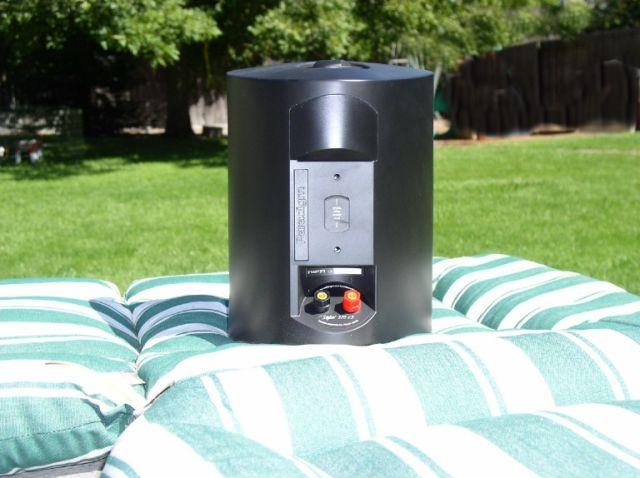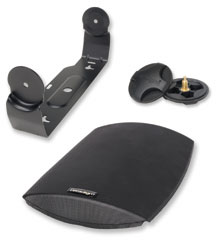Introduction
I've always enjoyed listening to music outdoors, whether working in the
garden, grilling on the BBQ, or just having a beer with friends. However,
the logistics of getting the music into the backyard was a hassle: dragging
a pair of bookshelf speakers on extra-long cable runs through the screen
door, then finding a place to set them where they are out of the way but can
still be heard.
The better solution, though one which many of us never seem to bother
with (this reviewer included), is to install a set of high-quality outdoor
speakers. So, when I was offered the chance to set up and review Paradigm's
Stylus 370 v.3 speakers, I jumped at the chance.
The Design
The Stylus series speakers, intended for outdoor use, are sealed-box designs
made of mineral-filled reinforced enclosures and shaped more like wedges
than traditional rectangular speakers.
The drivers consist of a 1" titanium dome tweeter covered by what
Paradigm calls "controlled WaveGuide faceplates," said to deliver extended
high frequency response, and a 6.5" mineral-filled polypropylene
midrange/woofer cone with an oversized magnet structure. The speakers
contain gold-plated binding posts recessed on the back panel, stainless
steel and brass hardware, and aluminum grilles and brackets. The 370s can be
mounted either horizontally or vertically using the supplied adjustable,
U-bracket, which allows for 1550 of adjustment.

Paradigm advertises the 370s as "Weather/Water/UV-resistant," so I
followed the instructions on their website to "feel free to install them
outside and leave them there." I have a feeling the custom install
companies are going to love these speakers, because they look
indestructible.
Set-up
Installing a set of outdoor speakers was actually quite simple, much to my
surprise, since I am not a do-it-yourself kind of guy around the house. The
three basic elements are connecting to a recei ver/amplifier
that is capable of supporting a second set of speakers (designated as "B" or
Zone 2), running the speaker wire from the receiver up to the installation
location (such as under a roof soffit), and finally mounting the speakers.
Unless you happen to have a well-stocked workshop, a quick trip to the local
hardware store for outdoor speaker cable and mounting hardware will be
necessary.
ver/amplifier
that is capable of supporting a second set of speakers (designated as "B" or
Zone 2), running the speaker wire from the receiver up to the installation
location (such as under a roof soffit), and finally mounting the speakers.
Unless you happen to have a well-stocked workshop, a quick trip to the local
hardware store for outdoor speaker cable and mounting hardware will be
necessary.
The first step required nothing more than attaching speaker cable to the
Zone 2 outputs of my Integra DTR 7.6 receiver. The Integra is designed for
an independent second zone operation, and has a set of speaker binding posts
dedicated for that purpose. The second part of the operation, running the
speaker cable to the location, involved following the path already trodden
by my friendly satellite installer. I used 16-gauge direct-burial speaker
cable specifically designed for outdoors/in-ground installation, since I
live in a part of northern California that gets plenty of rain. The speaker
wires followed the same track as the satellite cabling through a small hole
in the siding (making sure to re-seal the opening), then up the siding and
under the soffit, using small mounting clamps that I hammered into the
siding to anchor the speaker wires.
The final step involves attaching the supplied U-bracket mounting plate to
the surface of your location. Paradigm does not supply the actual mounting
hardware, since it doesn't know whether your installation will be into wood
siding, stucco, drywall, etc. Because I was installing the mounting clamp
directly into wood siding, nothing more than outdoor wood screws were
required. The U-clamp allows the speaker to be adjusted along its axis, so
you can choose to mount the speakers either horizontally or vertically. Once
the U-clamp is secured to the location, connect the speaker wires to the
multi-way binding posts, then unscrew the large caps on both ends of the
clamp, slide the speaker into place, and replace the caps. Loosening the
caps slightly allows for the speakers to adjust side-to-side, or in my case,
up and down, to ensure that the speakers were pointed down at my patio.

The entire operation took about half a day, and most of that time was
spent making sure that the outdoor cable runs were hidden as much as
possible. Installing the U-clamps and speakers was actually the shortest
part of the process. Now it was time to crack open a beer and conduct some
proper listening tests.
The Sound
The Paradigms are specifically designed for outdoor use, which means that
they create a very wide soundstage. Because of the physical characteristics
of my back patio, I ended up installing the Paradigms farther apart than the
1/2 - 3/4 of listening space-width recommended by the manufacturer.
Nonetheless, I could sit (or stand) just about anywhere on the patio and
still hear sound coming from each speaker. I had to almost stand directly
underneath one of the speakers before the stereo image disappeared.
I was pleasantly surprised by the detail reproduced by the Paradigms. Before
Phil Collins started doing soundtracks to Disney films, he was the virtuosic
drummer for the progressive band Genesis. Listening to the opening cut from
their mid-career album A Trick of The Tail, called "Dance on a Volcano", I could
follow Collins' tom-tom rolls as they panned across the soundstage.
Similarly impressive was the Paradigms' ability to project beyond the patio
(luckily I don't have to worry about the neighbors in back), as the sound
quality held up even as I standing a good 50 feet beyond the patio.
Regular readers of this magazine understand that one very important factor
in sound reproduction is the listening space. Attempting to recreate
high-quality music in an outdoor environment is particularly challenging,
due to a lack of exterior boundaries and control over ambient noise
conditions such as wind, helicopter overflights, or neighboring lawnmowers.
Thus, I was not focused on attempting to make fine distinctions in textures
or timbre during my listening period. Nonetheless, I was impressed by the
lack of any excessive boominess or harshness in the Paradigms, two things I
might have expected to hear in outdoor speakers. To the contrary, it was a
distinct pleasure to find myself taking in the small details of recordings
while standing over a Weber grill, watching the kids throw a ball around the
yard, and not worry about tripping over speaker wires running from the back
door.
Conclusions
To those readers who, like me, had not gotten around to creating an outdoor
listening environment, Paradigm has taken away your excuses. The 370 v.3s
are well-designed and engineered for easy installation, and will surprise
you with the quality of sound reproduction capable in outdoor speaker
enclosures. Highly recommended!
- Ross Jones -